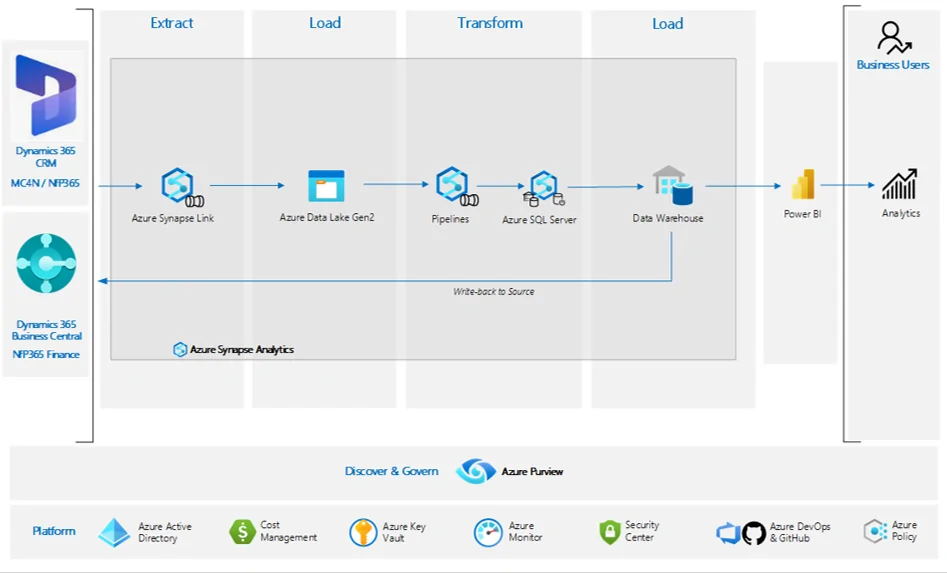We specialise in the provision of Modern Data Warehouses, in particular for Dynamics 365 CRM and Dynamics 365 Business Central

Data is essential for any organisation. It not only records what happened in the past, but also helps you understand why it happened and what you can do in the future.
But data is often scattered across different systems that don’t talk to each other. That makes it hard to get a complete picture of your organisation and its performance. That’s why you need an mhance reporting solution that brings all your data together in one place, in the cloud. This way, you can see everything that matters to you, from any angle. You can also enrich your data with additional information from external sources, such as market trends, customer feedback, or social media.
Once you have all your data in one place, you can transform it into useful insights that help you make better decisions. You can do this by creating a data warehouse that organises your data in a logical and consistent way. You can also define metrics and key performance indicators (KPIs) that measure your progress and success. And you can use advanced techniques such as predictive analytics and artificial intelligence (AI) to discover hidden patterns, trends, and opportunities.
To access these insights, you can use powerful data visualisation tools such as Microsoft Power BI. These tools let you create interactive dashboards and reports that show you what’s happening in your organisation, in real time. You can also share these insights with others, or send them back to your source systems to improve your processes and workflows.

Our Data Services Team can undertake each of the key elements required in delivering a Modern Data Warehouse:
- ELTL (Extract, Load, Transform, Load)
- Dimensional Modelling
- Data Enrichment
- Development of Measures and KPI’s
- Reporting & Analytics
- Write-back to Source (summaries, calculations)
Technologies We're Skilled In

Our teams are skilled in a number of applicable technologies, including:
- Azure Data Factories and SQL Server Integration Services
- Azure Data Lakes and Azure SQL
- Azure Synapse Link and Azure Synapse Analytics
- Power BI
- Azure Machine Learning
- Azure Purview
The core elements of this architecture

ELTL-based Architecture
- Utilising an Extract-Load-Transform-Load architecture (making use of Staging Areas) offers a number of practical advantages, including:
- It reduces contention on the source system(s) by avoiding any transformations during initial ingestion.
- The use of a staging area better facilitates the joining of data from multiple source systems – it also facilitates differing load strategies across systems.
- Data enrichment processes can be run/re-run from staging without recourse to the source systems.
Azure Synapse Link
- Extracting large amounts of data directly from the Dynamics 365 platform can present a challenge in terms of performance. Azure Synapse Link provides a much better approach wherein data is essentially synchronised from D365’s underlying SQL platform directly to Azure (in the form of a Data Lake), this avoiding any interaction with the D365 API.
Azure Data Lake Storage (ADLS)
- ADLS Gen-2 provides an extremely fast, highly cost-effective method of storing and accessing very large amounts of data.
Azure Synapse Analytics (ASA)
- By associating a Synapse Link Data Lake with an ASA workspace, we effectively open up a world of possibilities in terms of data enrichment and analytics, including machine learning.
Azure SQL
The cloud equivalent of SQL Server, Azure SQL is a perfect platform for a modern data warehouse. A combination of ASA Pipelines and SQL Stored Procedures will:
- ingest the Lake data to a staging schema in Azure SQL
- transform the data into an appropriate Dimensional Model
- enrich the data through the provision of a range of calculated fields and metrics which will then be available for consumption by an organisation’s preferred analytical tools, such as Microsoft Power BI
- overlay any specific reporting requirements such as mandatory KPI’s/outputs
The use of an end-to-end Azure architecture means that customers will have access to all elements of consumption and operational costs/metrics via Azure Cost Management.
Dimensional Model

The key element in delivering a successful Data Warehouse is the design and implementation of an appropriate Dimensional Model. Our Data Services Team will work with you to ensure:
- That we identify the key Business Processes that need to be incorporated into the model
- That we determine the appropriate grain for each Measure table in the model
- That we select appropriate Dimensions to facilitate cross-organisation reporting
- That we cater for any required historical reporting
A well-designed dimensional model lays the foundation for a successful data warehouse:
- It is designed to be performant for large-scale reporting
- It will provide consistent reporting over time
- It is much more readily consumed by non-technical users
Implementation

Implementation of a Data Warehouse can be undertaken on a Phased basis, taking individual business processes in turn. Layering of functionality (Model, Analytics, KPI’s Machine Learning) can also be phased.
mhance has particular expertise in the provision of Data Warehouse solutions for the non-profit sector.
Get started with our Modern Data Warehouse
Contact us to find out more about how our Modern Data Warehouse can support your organisation.

